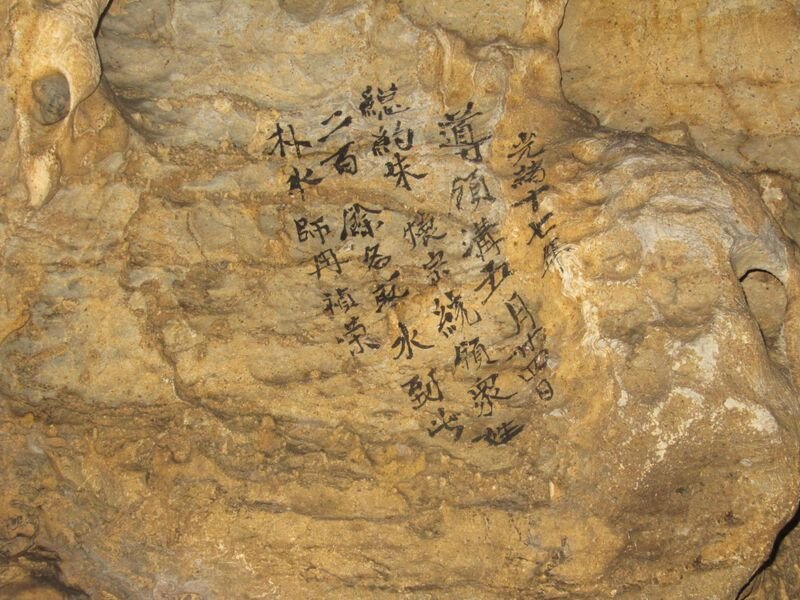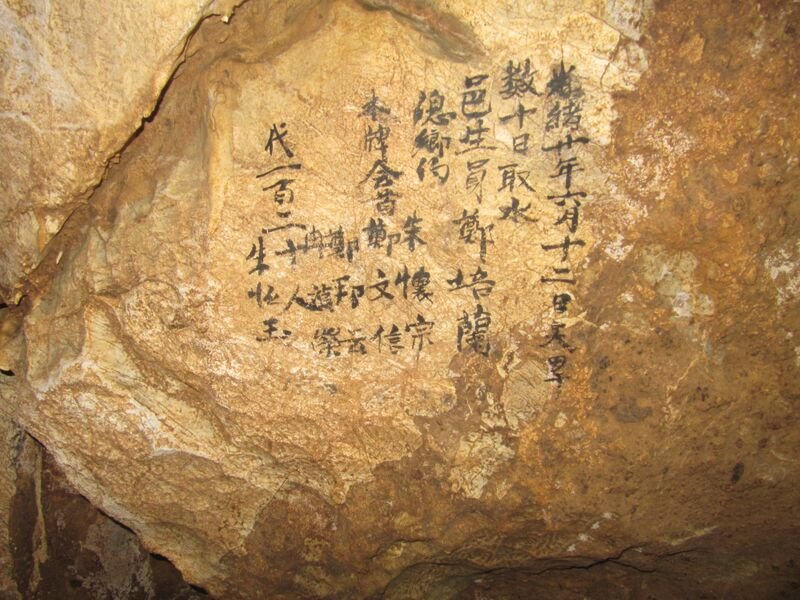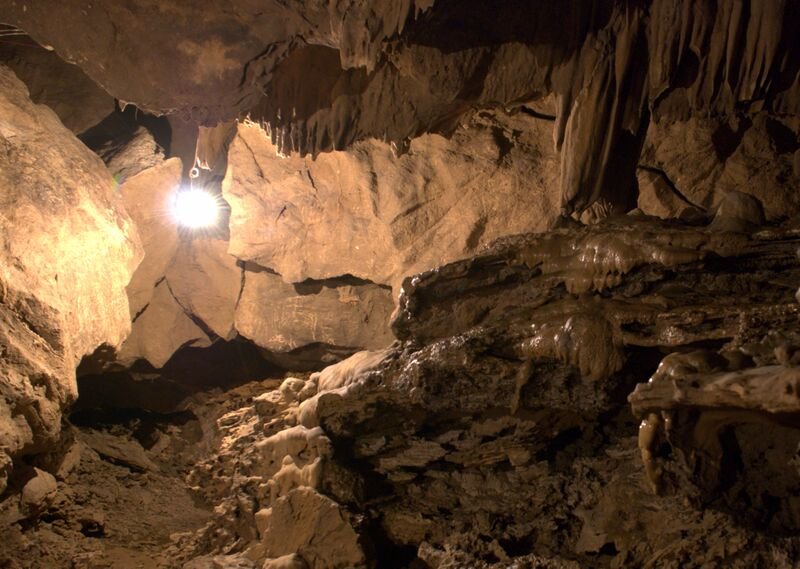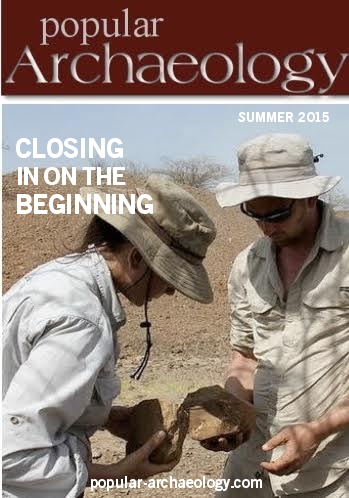
University of Cambridge—An international team of researchers has discovered unique ‘graffiti’ on the walls of a cave in central China, which describes the effects drought had on the local population over the past 500 years.
The information contained in the inscriptions, combined with detailed chemical analysis of stalagmites in the cave, together paint an intriguing picture of how societies are affected by droughts over time: the first time that it has been possible to conduct an in situ comparison of historical and geological records from the same cave. The results, published in the journal Scientific Reports, also point to potentially greatly reduced rainfall in the region in the near future, underlying the importance of implementing strategies to deal with a world where droughts are more common.
The inscriptions were found on the walls of Dayu Cave in the Qinling Mountains of central China, and describe the impacts of seven drought events between 1520 and 1920. The climate in the area around the cave is dominated by the summer monsoon, in which about 70% of the year’s rain falls during a few months, so when the monsoon is late or early, too short or too long, it has a major impact on the region’s ecosystem.
“In addition to the obvious impact of droughts, they have also been linked to the downfall of cultures – when people don’t have enough water, hardship is inevitable and conflict arises,” said Dr Sebastian Breitenbach of Cambridge’s Department of Earth Sciences, one of the paper’s co-authors. “In the past decade, records found in caves and lakes have shown a possible link between climate change and the demise of several Chinese dynasties during the last 1800 years, such as the Tang, Yuan and Ming Dynasties.”
According to the inscriptions in Dayu Cave, residents would come to the cave both to get water and to pray for rain in times of drought. An inscription from 1891 reads, “On May 24th, 17th year of the Emperor Guangxu period, Qing Dynasty, the local mayor, Huaizong Zhu led more than 200 people into the cave to get water. A fortune-teller named Zhenrong Ran prayed for rain during the ceremony.”
Another inscription from 1528 reads, “Drought occurred in the 7th year of the Emperor Jiajing period, Ming Dynasty. Gui Jiang and Sishan Jiang came to Da’an town to acknowledge the Dragon Lake inside in Dayu Cave.”
While the inscriptions are business-like in tone, the droughts of the 1890s led to severe starvation and triggered local social instability, which eventually resulted in a fierce conflict between government and civilians in 1900. The drought in 1528 also led to widespread starvation, and there were even reports of cannibalism.
___________________________________________
 Inscription from 1891 found in Dayu Cave. It reads: On May 24th, 17th year of the Emperor Guangxu period (June 30th, 1891 CE), Qing Dynasty, the local mayor, Huaizong Zhu led more than 200 people into the cave to get water. A fortuneteller named Zhenrong Ran prayed for rain during a ceremony. Photo credit L. Tan
Inscription from 1891 found in Dayu Cave. It reads: On May 24th, 17th year of the Emperor Guangxu period (June 30th, 1891 CE), Qing Dynasty, the local mayor, Huaizong Zhu led more than 200 people into the cave to get water. A fortuneteller named Zhenrong Ran prayed for rain during a ceremony. Photo credit L. Tan
____________________________________________________________
 Inscription from 1894 found in Dayu Cave. It reads: Draught lasted more than one month. On June 12th, 2oth year of the Emperor Guangxu period (July 14th ,1894 CE), Qing Dynasty, scholar Peilang Zheng, mayor Huaizong Zhu, heads of the clan Wenxin Zheng and Bangyun Zhen, and Zhenrong Ran. Hengyu Zhu, led more than 120 persons to the cave to get water. Photo Credit L. Tan
Inscription from 1894 found in Dayu Cave. It reads: Draught lasted more than one month. On June 12th, 2oth year of the Emperor Guangxu period (July 14th ,1894 CE), Qing Dynasty, scholar Peilang Zheng, mayor Huaizong Zhu, heads of the clan Wenxin Zheng and Bangyun Zhen, and Zhenrong Ran. Hengyu Zhu, led more than 120 persons to the cave to get water. Photo Credit L. Tan
_____________________________________________________________
 Researchers reading the inscription record within the cave. Photo credit: L. Tan
Researchers reading the inscription record within the cave. Photo credit: L. Tan
____________________________________________________________
“There are examples of things like human remains, tools and pottery being found in caves, but it’s exceptional to find something like these dated inscriptions,” said Dr Liangcheng Tan of the Institute of Earth Environment at the Chinese Academy of Sciences in Xi’an, and the paper’s lead author. “Combined with the evidence found in the physical formations in the cave, the inscriptions were a crucial way for us to confirm the link between climate and the geochemical record in the cave, and the effect that drought has on a landscape.”
The researchers removed sections of cave formations, or speleothems, and analysed the stable isotopes and trace elements contained within. They found that concentrations of certain elements were strongly correlated to periods of drought, which could then be verified by cross-referencing the chemical profile of the cave with the writing on the walls.
When cut open, speleothems such as stalagmites frequently reveal a series of layers that record their annual growth, just like tree rings. Using mass spectrometry, the researchers analysed and dated the ratios of the stable isotopes of oxygen, carbon, as well as concentrations of uranium and other elements. Changes in climate, moisture levels and surrounding vegetation all affect these elements, since the water seeping into the cave is related to the water on the surface. The researchers found that higher oxygen and carbon isotope ratios, in particular, corresponded with lower rainfall levels, and vice versa.
____________________________________________
 Speleothems within the cave were analyzed to acquire clues to climate change. Photo credit: L. Tan
Speleothems within the cave were analyzed to acquire clues to climate change. Photo credit: L. Tan
__________________________________________________________
The researchers then used their results to construct a model of future precipitation in the region, starting in 1982. Their model correlated with a drought that occurred in the 1990s and suggests another drought in the late 2030s. The observed droughts also correspond with the El Niño-Southern Oscillation (ENSO) cycle. Due to the likelihood that climate change caused by humans will make ENSO events more severe, the region may be in for more serious droughts in the future.
“Since the Qinling Mountains are the main recharge area of two larger water transfer projects, and the habitat for many endangered species, including the iconic giant panda, it is imperative to explore how the region can adapt to declining rain levels or drought,” said Breitenbach. “Things in the world are different from when these cave inscriptions are written, but we’re still vulnerable to these events – especially in the developing world.”
__________________________________________________________
Source: Press release of the University of Cambridge
__________________________________________________________
 Read more in-depth articles about archaeology with a premium subscription to Popular Archaeology Magazine.
Read more in-depth articles about archaeology with a premium subscription to Popular Archaeology Magazine.
In addition, the latest Popular Archaeology ebook is now available.
______________________________________________
Travel and learn with Far Horizons.
____________________________________________
 This richly illustrated ebook version of a recent Popular Archaeology issue includes the following stories: The discovery of the tomb of a previously unknown pharaoh that is shedding light on a lost ancient Egyptian dynasty; how genetics is revolutionizing what we know about human evolution and our prehistoric past; one scholar’s controversial ‘New Chronology’ and how it supports the historicity of the biblical Exodus; how archaeologists are unearthing new history in Williamsburg, Virginia, a seat of British colonial power in 18th century America; the discovery of the remains of a major Roman legionary base in Israel; the unearthing of an ancient Judean fortified settlement in the borderlands between the biblical kingdoms of ancient Judah and the Philistines; and how archaeologists are uncovering evidence of what may have been an important administrative center of Judah during the 8th century BCE. Now available from Amazon.com!
This richly illustrated ebook version of a recent Popular Archaeology issue includes the following stories: The discovery of the tomb of a previously unknown pharaoh that is shedding light on a lost ancient Egyptian dynasty; how genetics is revolutionizing what we know about human evolution and our prehistoric past; one scholar’s controversial ‘New Chronology’ and how it supports the historicity of the biblical Exodus; how archaeologists are unearthing new history in Williamsburg, Virginia, a seat of British colonial power in 18th century America; the discovery of the remains of a major Roman legionary base in Israel; the unearthing of an ancient Judean fortified settlement in the borderlands between the biblical kingdoms of ancient Judah and the Philistines; and how archaeologists are uncovering evidence of what may have been an important administrative center of Judah during the 8th century BCE. Now available from Amazon.com!
____________________________________________





